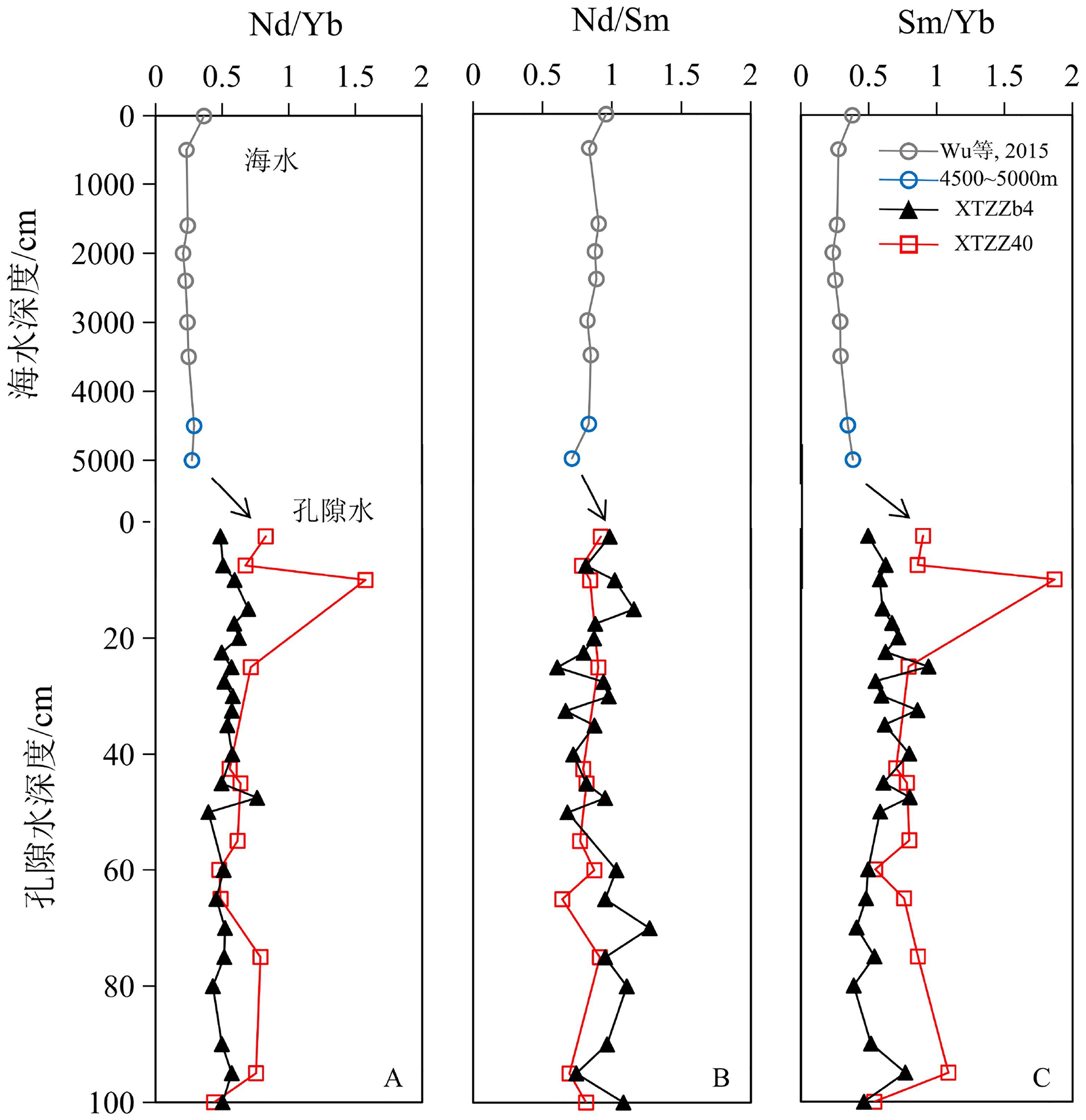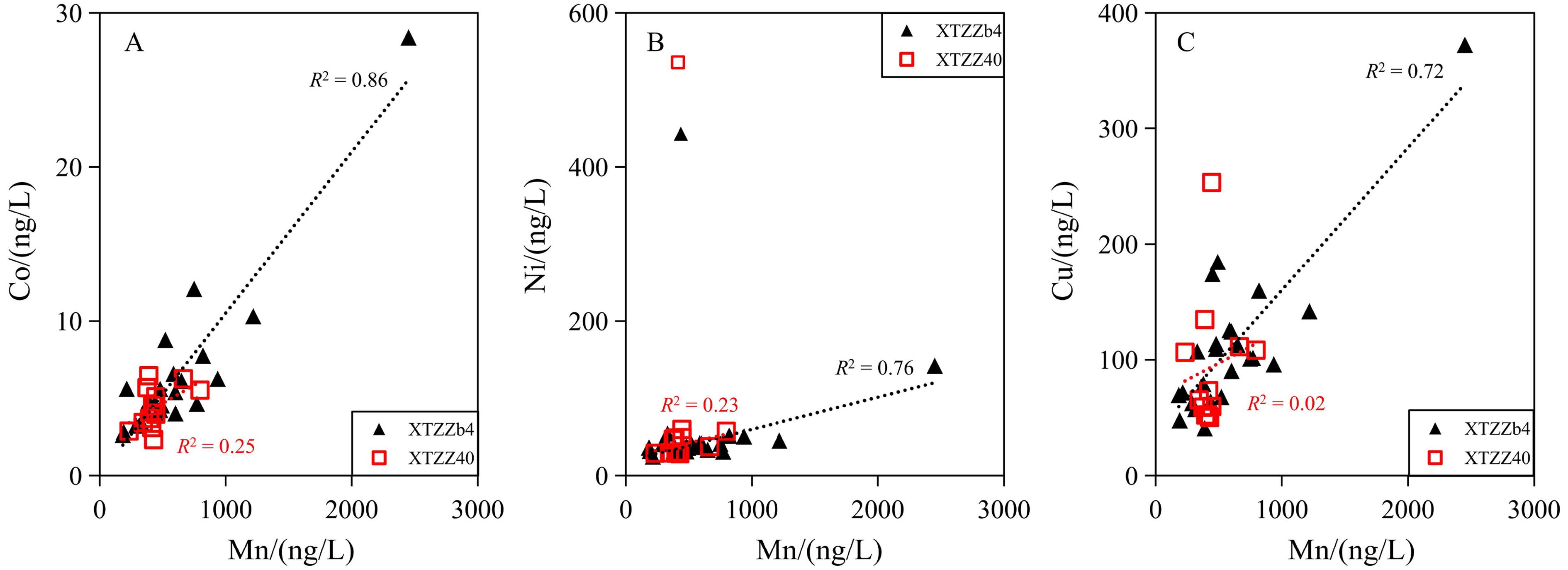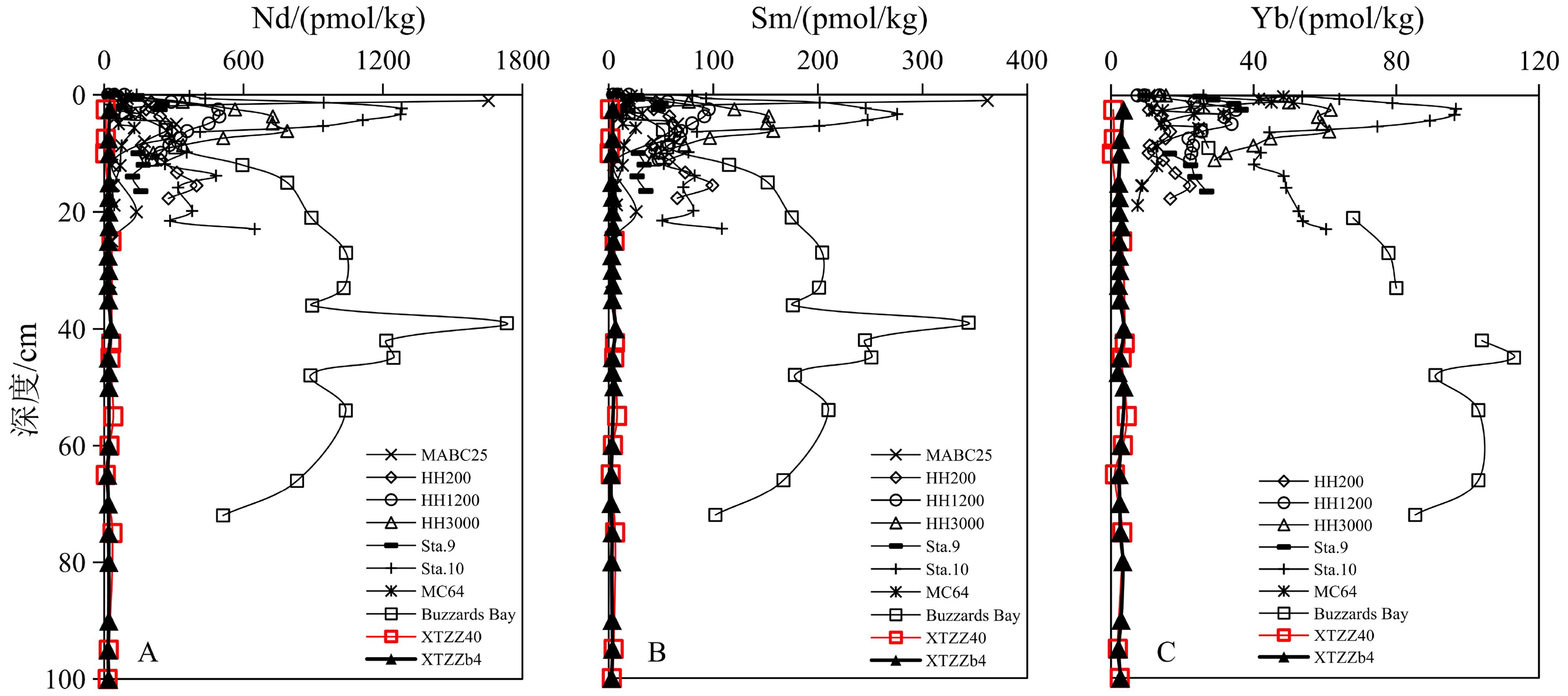Rare earth element geochemistry characteristics and implications of pore-water from deep sea sediment in Western Pacific Ocean
-
摘要: 为探索深海孔隙水中稀土元素的生物地球化学循环过程,对太平洋菲律宾海九州-帕劳海脊东、西两侧的两个钻孔沉积物进行了高精度的孔隙水采样工作,分析了主、微量元素和稀土元素的地球化学特征,并对稀土元素的浓度、配分模式以及分馏特征进行了详细的讨论。结果表明:这两个钻孔沉积物均处于氧化环境,表现出海水-沉积物界面和浅层孔隙水(2.5~20 cm)中相对富集轻稀土和中稀土,而中层(25~60 cm)和深层沉积物(>65 cm)孔隙水中则相对富集重稀土元素的特征。初步推断有机质和锰(氢)氧化物的分解和吸附作用是造成孔隙水中稀土元素分馏的主要因素。相比于九州-帕劳海脊的东、西两侧海域,孔隙水中的稀土元素浓度和分馏程度存在一定的差异,周围环境中的矿物组成和锰(氢)氧化物等是其主要的控制因素,但是研究区域深海孔隙流体并不能为海洋贡献稀土元素。Abstract: In order to explore the biogeochemical process of the rare earth elements in deep sea pore water, high-precision samples were collected from the two stations of the Philippine Sea. Geochemical characteristics of the main elements, trace elements and REE are analyzed and the concentration, distribution and fractionation of the REE discussed in details. It is found that both the two stations are in an oxidizing environment. HREE and MREE are enriched around the water-sediment interface and in the shallow pore water (2.5~20 cm), while MREE and HREE enriched in the middle (25~60 cm) and lower layers of sediments. We believe that the decomposition and adsorption of organic matter and Mn oxide are the main factors for the fractionation of REE in pore water. Concentrations and fractionations of REE in pore water are found different in the East and West sides of the Kyushu Palau Ridge because of the difference in volcanic activities, mineral composition and Mn oxide in the surrounding environment. However, the pore fluid of the study area makes no contribution of REE to the ocean.
-
Keywords:
- rare earth element /
- pore water /
- trace elements /
- geochemistry /
- Philippine Sea
-
周期阶坎是海底陆坡常见的地貌单元,以连续的波状底形为特征,是深水沉积体系的重要场所,是现今海洋学研究的热点。周期阶坎一般发育环境分为海底和陆上两类,其中在海底陆坡和坡折位置处向上游迁移的长波状底形最为常见。国外学者Paker和他的助手首先在明渠模拟实验中观察到一系列向上游迁移的台阶状底形,并正式提出“周期阶坎(cyclic steps)”一词[1]。国内钟广法等[2-3]最早发现并报道了南海东北部陆坡区海底峡谷谷底、越岸区和出口部位存在大量超临界流成因的大型沉积物波,将其解释为“周期阶坎”。大多学者对海底周期阶坎进行了研究[2-5],但对于琼东南地区现今海底周期阶坎的研究颇少。在琼东南地区,以往学者更加关注于海底峡谷的研究,并发现在海底峡谷或水道中常伴生一种类似台阶状的底形,且都有规律地朝一个方向运动,最初认为这种底形为海底沉积物波[6]。然而关于琼东南陵水凹陷现今海底是否为周期阶坎还有待考究,研究区域内阶坎底形和其形成机制有助于理解海底流体活动,并为其他区域海底地貌单元识别提供参考。
本文基于琼东南盆地陵水凹陷浅层285 km2三维地震数据,对周期阶坎的构型和形成原因进行了分析。南海陆坡周期阶坎研究对加深海底地貌单元以及重力流沉积发育控制因素具有重要的意义。
1. 地质概况
琼东南盆地位于南海北部大陆边缘,地质构造复杂多变,属于陆架较窄和陆坡较陡的非典型被动大陆边缘性盆地[7]。物源主要来自越南和海南岛的双物源供给,发育滑塌体、峡谷和海底扇等沉积体系[7-8]。陆坡自西北向东南坡度整体逐渐变缓,陆坡海底发育大量的水道和大规模的重力流沉积[9]。
琼东南盆地陆坡区自西向东按照陆坡的宽度、有无明显的坡折带和陆坡倾角大小,分为盆地西部、盆地中部和盆地东部。陵水凹陷研究区位于琼东南盆地中部、水深700~1500 m的上陆坡区,坡度大约为2°~16°(图1a)。
![]() L1测线号6053,研究区最西侧;L2、L3测线号分别为6353、6653,依次靠近水道左侧区域;L4测线号6953,左侧水道壁附近;L5测线号7253,水道内部;L6测线号7553,右侧水道壁附近;L7和L8测线号分别为7854、8147,研究区最东侧。L1 inline 6053, on the westernmost side of the study area; L2, L3 inline 6353 and 6653, respectively, close to the left side of the channel; L4 inline 6953, near the left side of the channel wall; L5 inline 7253, channel Inside; L6 inline 7553, on the right side of the channel wall; L7 and L8 inline are 7854 and 8147 respectively, the easternmost side of the study area.
L1测线号6053,研究区最西侧;L2、L3测线号分别为6353、6653,依次靠近水道左侧区域;L4测线号6953,左侧水道壁附近;L5测线号7253,水道内部;L6测线号7553,右侧水道壁附近;L7和L8测线号分别为7854、8147,研究区最东侧。L1 inline 6053, on the westernmost side of the study area; L2, L3 inline 6353 and 6653, respectively, close to the left side of the channel; L4 inline 6953, near the left side of the channel wall; L5 inline 7253, channel Inside; L6 inline 7553, on the right side of the channel wall; L7 and L8 inline are 7854 and 8147 respectively, the easternmost side of the study area.2. 数据和方法
本研究所使用的数据主要源于中国海洋石油有限公司从琼东南盆地获得并拥有的约300 km2的三维地震数据。研究区三维地震数据面元大小为12.5 m×12.5 m(Inline×Crossline),采样率为2 ms,频带宽度为6~90 Hz,主频约45 Hz,最大垂向分辨率(λ/4)约15 m。
利用GeoFrame软件对研究区现今海底浅层目的层同相轴进行解释,解释的网格精度为10×10(CDP),并将解释的层位进行时深转换,提取地震属性倾角、方位角和均方根(图2a为倾角属性平面图)等。利用解释的三维地震层位数据结合Surfer软件绘制了现今海底地形图(图1b)。研究区海底地形图揭示现今海底发育阶梯状地貌,陆坡上存在多条小水道和一条清晰的大型水道(由两支小水道复合而成即水道复合体),水道壁附近台阶形态杂乱(图1b))。
3. 周期阶坎底形的识别及特征描述
周期阶坎的识别依据主要基于三点:① 周期阶坎经常发育在高坡度和坡折带区域[10-16];② 当坡度超过0.6°时,浊流可能达到超临界流状态[16-18];③ 周期阶坎发育的波长较长,多为链状,不对称,向上游迁移,形态似台阶状[16-17, 19]。研究区发育的底形所处位置、坡度以及形态特征与形成“周期阶坎”的条件吻合。
NW-SE向剖面上周期阶坎(图2b)表现为波状亚平行结构地震相,多组同相轴互相平行并呈波浪状起伏,波形起伏较小,不对称,波脊逆坡迁移。波状底形是由波脊和波谷相间构成,似阶梯状,高度为6~10 m。周期阶坎类型为长波形、不对称、似正弦曲线多数向上游迁移,部分向下游迁移的新月形。
由于海水与地层之间的密度差,上下地层的振幅反射特征发生了明显变化,波阻抗系数增大,因此地震同相轴连续性较好,利于研究周期阶坎的具体形态特征。选取8条测线(图1b中L1—L8)计算和分析每一测线上周期阶坎的几何构型(图2c)。使用几何构型参数(波长(L)、倾角(θ)、波高(H)、迎流面长度(Lstep)、背流面长度(Llee)、迎流面夹角(α)、背流面夹角(β)以及迎流面与背流面长度的比值(R)),刻画海底阶梯形态。
数据统计结果表明:单个周期阶坎波高4~10 m,波长20~150 m,倾角2°~14°,波长/波高为4~30。研究区自西向东(自L1到L8)阶坎波长随着坡度变缓依次增加(图3),即区域内周期阶坎之间的间距不等。研究区水道内部的阶坎波长(L5)较水道外部波长变化曲线趋势更加明显。水道壁附近(L4、L6)波长随深度变化数据有跳跃变化。单个周期阶坎的迎流面与背流面随深度变化:① 长度:迎流面长20~140 m,背流面长10~40 m。迎流面长度波动范围更广,背流面长度变化则更加集中(图4);② 角度:迎流面角度0.1°~0.15°,背流面角度0.2°~0.8°。整个曲线趋势总体是背流面角度远大于迎流面,极少数迎流面角度大于背流面角度。随深度变化整个8条测线上的周期阶坎:① 迎流面和背流面长度均逐渐增加,但迎流面长度增长趋势远大于背流面;② 迎流面角度变化集中,背流面角度波动范围更广。
![]() 图 3 波长随深度变化曲线图 (测线位置见图1b)Figure 3. The relation between wavelength and depth
图 3 波长随深度变化曲线图 (测线位置见图1b)Figure 3. The relation between wavelength and depth4. 讨论
琼东南盆地陵水凹陷现今海底开放陆坡上分布成片大面积的周期阶坎底形是如何形成的?有哪些有利条件导致了这些底形的形成?针对这些问题,在前人的研究基础之上综合研究区所处地质环境对形成区域周期阶坎底形的形成过程和成因机制进行了详细的探究。陵水凹陷现今海底发育的周期阶坎底形分布范围广、数量多、类型多而集中。
4.1 周期阶坎形成过程
周期阶坎的形成与流体动力学有关。区域内发育的周期阶坎底形是由于浊流携带的陆源碎屑物质通过海底峡谷或水道重力流流体通道从陆架途径陆坡向下游搬运,在搬运途中随流体动力学参数弗劳德数(
$Fr = U/\sqrt {RCgD} $ ,其中,R:浊流中沉积物折算密度,C:浊流中平均体积浓度,D:浊流的厚度)变化而形成的一种阶梯状底形[20]。研究区成片大面积分布的周期阶坎底形足够说明水流携带的泥沙等碎屑物质能量强。靠近上陆坡区,浊流能量强,单位时间内形成的周期阶坎底形数目多,在立体图上显示出它们之间排列更加紧凑(图1b)。靠近下陆坡区,坡度减小,水动力减弱,沉积物沉积厚度变薄,单位时间形成的周期阶坎数目减小,故形成的周期阶坎底形在下陆坡间距增大(图1b)。单独一条测线上形成的周期阶坎形态类同,但大小不同。一个完整的周期阶坎形成,需要两种水流流态:① 水流携带的泥沙等碎屑物质从阶梯底部向顶部运动过程中,由于水流流速不断地减小,流体从上一个阶段的超高速超临界流结束不断地向亚临界流转化,一部分水流动能被紊流消散,剩余的动能转化为位能,会导致液面升高,即水流产生的惯性小于流体自身的重力,形成亚临界流,此时Fr<1[4, 21]。② 当Fr>1时,水流向下游流动的惯性大于向上游传播的波速,产生超临界流,此时不可能有向上游移动的波[22],从而形成长波长的迎流面。理想状态下,流体从第一个阶坎底部向顶部水力跳跃完成第一个周期阶坎,接下来将剩余的能量用来完成第二个周期阶坎,依次类推,直到水跃能量消失,底形将不存在。周期阶坎的形成是浊流从超临界流到亚临界流过程中水力跃变形成的底形。周期阶坎由一系列连续的陡峭背流面和平缓迎流面组成,并且经常在背流面与迎流面转换区域形成冲沟或深坑[20]。依据侵蚀作用的强弱,分为三种类型:① 沉积型周期阶坎。水流中携带的沉积物很难被带走从而在迎流面卸载,当超临界流流经每个阶梯底部时,向亚临界流转化并产生水跃。水流继续沿着迎流面上倾方向流动,流速逐渐减缓,水流能态进一步降低,水流侵蚀作用被削弱因而以沉积作用为主[18, 23]。② 过渡型周期阶坎。水流能态不足以达到超临界流形成水跃,沉积作用与侵蚀作用相当。③ 侵蚀型周期阶坎。当水流经过阶梯顶点后位能最大,位能沿背流面下倾方向不断加速转化为动能,即水流流速逐渐增大使得浊流携带的碎屑物质很难被保留下来,其水流流态从亚临界流向超临界流转化,因此以侵蚀作用为主,从而形成的阶坎底形背流面陡峭[24]。长波状周期阶坎的形成,迎流面以沉积作用为主,背流面以侵蚀作用为主。
研究区周期阶坎迎流面长度主要大于背流面长度,在规模上属于中型沉积型周期阶坎。随深度的增加,沉积物在平缓的一侧不断加积,使得周期阶坎迎流面一侧长度不断变长。周期阶坎平缓的迎流面和陡峭的背流面,使得沉积物发生了沉积/侵蚀差异作用,最终沉积波向浊流上游方向迁移逐渐形成月牙状[4, 23, 25-26]。另外,迎流面长度与背流面长度比值大于数值1,即周期阶坎底形呈不对称性。周期阶坎迎流面主要是以亚临界流沿上倾方向加速沉积形成的平缓状斜坡,而背流面是超临界流沿下倾方向水跃侵蚀作用形成的陡峭坡[18, 23],说明迎流面沉积粒度比背流面粗。周期阶坎呈现的有规律的向下游排列的线性构造底形指示沉积物向下游搬运,其沉积波上游方向粒度最粗,向下游方向粒度逐渐变细。
4.2 周期阶坎的成因机制
近年来,众多学者研究认为周期阶坎在海底广泛存在[4, 16, 18]。Cattane等[20]研究认为周期阶坎的形成可能是浊流与原先存在的不规则地形之间相互作用,但Kubo等质疑Cattane等只是简单地夸大了地形对形成周期阶坎的影响,并没有考虑到浊流水力跃变输送的能量。之后,Spinewine等[27]实验结果和Kostic等[24]数值模拟结果均一致表明持续的浊流易于形成周期阶坎,与预先存在的地形没有直接的联系。王海荣等[28]认为浊流形成的沉积波具有迁移特征,周期阶坎的形成是多种成因共同的结果。在前人的研究基础之上,笔者从浊流和坡度两方面对研究区的周期阶坎进行了分析。
4.2.1 浊流
浊流是重力流的一种表现形式,浊流的流体动力学影响了深水沉积体系结构单元的演化,可以分为超临界流和亚临界流两种。浊流内部携带的碎屑物质属于高密度流体,流速一般很大[29]。研究区沉积波的地震剖面显示下切水道十分发育,周期阶坎的形成是浊流作用的结果。
周期阶坎与浊流有关的因素有:① 与浊流中高密度流体密切联系。陵水凹陷现今海底陆坡区靠近物源,地形高差大,偶然的事件沉积(异重流)引起泥砂混杂持续性、密度高的沉积物容易形成周期阶坎底形,且Cartigny数值模拟实验[12]证实,沉积物浓度是发生水力跃变的有力因素。水跃往往发生在沉积物浓度确定的范围内,浓度越大,形成周期阶坎的个数越多,规模越大[14]。② 与浊流粒度和沉积速率有关。丰沛的碎屑物质从“源”系统途经研究区汇入到深海盆地,沉积物沉积速率逐渐降低,沉积物粒度由粗变细。整个周期阶坎的迎流面长度自L1到L8不断地变长,其中沉积物的沉积厚度迎流面比背流面厚,形成的周期阶坎底形往往不稳定。研究区西部沉积物粒度比东部粗,西部沉积物的沉积速率比东部高。高的沉积速率易于波状底形的完整保存,而且容易形成不对称底形[14]。③ 与浊流的流量和流速有关。随流速的增加底形会依次出现:无颗粒运动的平坦床沙、沙纹、沙浪、沙丘、过渡丘(或低角度沙丘)、平坦床沙、周期阶坎、流槽和凹坑[22, 30-31]。随浊流流量的增加,超临界流的侵蚀能力逐渐增强,形成水力跃变的可能性越高,更容易形成周期阶坎底形。在前人理论研究基础之上,笔者认为研究区浊流的流速高而稳定,因此形成了大范围的周期阶坎底形。
周期阶坎的形成、演化过程与发育在陆架边缘斜坡和峡谷水道中的浊流体系密不可分[32]。到目前为止,部分学者已经证实了浊流形成的沉积波能够以周期阶坎底形出现[2, 19, 21, 33]。周期阶坎底形甚至在高山流水、冰川中都可以出现。
4.2.2 坡度
地形坡度是控制超临界流体发生水跃形成周期阶坎底形的关键因素。地形坡度较大时,浊流携带的沉积物位能高,其沿斜坡分力较大,侵蚀作用明显,因此形成侵蚀型和粗粒度的沉积型周期阶坎;随研究区域坡度的变缓,浊流所携带的沉积物能量逐渐递减,流体的搬运能力相应地也逐渐减弱,水力跳跃后在阶梯顶部需要的能量更大,其缓冲距离加大,大量的沉积物开始堆积,粒度较细的沉积物开始沿着上倾斜坡不断地堆积形成长高比不断增大的沉积型周期阶坎[23, 34-35]。鲁勇的水槽实验表明,在坡道转换处会发生水跃,其水跃强度随坡度的增加而增加。在坡度、水流量和体积比浓度相等的情况下,坡上的平均沉积厚度小于坡下平均沉积厚度,即迎流面沉积速率与背流面的沉积速率不同[34]。一般情况下,陡峭的坡度和高密度的弗劳德数有利于周期阶坎的形成[36]。然而,坡度超过0.92°形成周期阶坎底形可能性会降低。坡度越陡,流体重力沿斜坡的分量增大促使流体不断加速,从而抑制流体内产生水跃的能量且增大了转化为亚临界流的可能性[18]。
坡度是超临界流水形成周期阶坎底形的前提要素[3, 18]。在一定的条件下,由陡峭的斜坡过渡到相对平缓的斜坡可能会导致浊流发生水力跃变[37]。
5. 结论
(1)陵水凹陷现今陆坡海底具备的坡度较陡、近物源等为周期阶坎底形的发育提供了有利条件,周期阶坎底形是构成深水沉积体系的重要沉积单元。
(2)陵水凹陷现今海底发育一条宽约6.5 km具有明显侵蚀特征的大型水道,是构成“源-汇”系统的重要通道。水道内外发育的周期阶坎底形在地震剖面上表现为连续波状亚平行强振幅地震相。周期阶坎的发育指示现今海底浊流流速急剧,流量大。
(3)通过对周期阶坎底形形成机制进行分析,认为浊流和坡度是形成周期阶坎的最主要的因素。周期阶坎在坡度适中、浊流发育的地带容易形成。
-
表 1 孔隙水中主量元素和微量元素的分析结果
Table 1 Concentrations of major and trace elements in the pore-water
站位 深度/cm Ca/(mg/L) K/(mg/L) Mn/(ng/L) Co/(ng/L) Cu/(ng/L) Zn/(ng/L) Sr/(μg/L) Mo/(μg/L) XTZZ40 2.5 259 367 796 5.5 108 2 574 6 561 9.17 7.5 259 363 428 2.3 50 1 713 6 663 6.78 10 259 392 414 3.1 52 2 137 6 593 10.4 25 258 394 346 3.4 65 1 449 6 432 9.34 42.5 259 425 390 6.5 135 2 984 6 386 11.1 45 259 433 445 5.1 253 3 955 6 465 11.4 55 255 431 445 4.0 60 958 6 409 12.9 60 265 441 421 4.5 73 947 6 929 12.4 65 261 450 664 6.3 111 2 758 6 648 12.3 75 267 433 397 3.7 52 1 634 6 154 11.8 95 263 405 376 5.7 59 927 6 379 13.6 100 305 457 233 2.9 106 1 116 6 510 16.2 XTZZ64 2.5 311 403 184 2.6 70 1 098 6 858 14.7 7.5 315 421 389 4.8 41 1 311 6 845 9.02 10 323 447 2 451 28.4 372 1 983 6 976 8.25 15 267 411 586 6.6 126 2 164 6 238 4.17 17.5 285 439 771 4.7 102 1 748 6 560 9.07 20 288 446 649 6.1 113 2 965 6 584 9.71 22.5 302 454 493 4.5 185 2 573 6 667 9.81 25 305 443 601 4.0 90 1 806 6 564 8.20 27.5 319 453 480 5.6 109 1 477 6 738 9.65 30 282 408 1 219 10.3 142 1 731 6 307 9.38 32.5 301 434 330 3.4 107 1 406 6 074 8.19 35 313 452 215 5.6 72 1 536 6 754 10.1 40 303 444 379 4.0 79 1 067 6 605 7.03 45 300 446 313 3.2 57 1 025 6 588 8.48 47.5 301 441 749 12.1 101 1 215 6 660 9.48 50 300 434 521 8.8 68 1 178 6 570 7.18 60 290 445 290 3.3 63 1 609 6 604 9.59 65 313 465 191 2.8 48 1 044 6 563 7.82 70 303 449 600 5.4 124 2 062 6 481 8.60 75 303 450 480 4.2 114 5 675 6 476 8.85 80 314 461 436 4.7 64 1 873 6 350 9.04 90 303 514 820 7.8 160 1 953 6 425 15.7 95 330 488 451 3.9 174 1 671 6 808 14.7 100 326 483 936 6.3 96 1 590 6 491 13.0 表 2 孔隙水中稀土元素的分析结果
Table 2 Concentration of REEs in the pore-water
pmol/kg 站位 深度/cm La Ce Pr Nd Sm Eu Gd Tb Dy Ho Er Tm Yb Lu XTZZ40 2.5 46.39 27.47 1.85 7.48 1.28 0.13 1.14 0.01 0.61 0.04 1.54 0.17 0.63 7.5 21.11 32.86 1.85 7.69 1.54 0.24 1.55 0.14 0.86 0.07 2.13 0.18 0.79 0.04 10 12.23 20.50 1.13 5.00 0.93 0.05 0.84 0.04 0.40 0.01 1.47 0.15 0.22 0.05 25 69.26 96.41 8.15 31.97 5.57 1.26 5.53 1.02 5.27 1.10 6.96 0.71 3.10 0.50 42.5 49.76 26.83 7.04 30.59 6.06 1.27 6.93 1.00 5.42 1.15 4.66 0.74 3.82 0.48 45 67.64 94.41 6.95 27.25 5.24 0.99 5.49 0.53 3.75 0.89 6.71 0.48 2.97 0.43 55 116.28 90.07 9.16 39.21 7.99 1.03 8.33 1.12 6.90 1.12 6.38 0.86 4.42 0.53 60 47.02 53.73 5.35 22.91 4.12 0.84 5.92 0.72 4.41 1.01 4.93 0.49 3.33 0.47 65 11.24 29.78 1.82 7.55 1.84 0.18 1.38 0.05 1.11 0.05 2.31 0.20 1.07 0.05 75 33.66 50.47 7.27 35.83 6.16 1.66 7.31 1.03 6.08 0.98 4.40 0.65 3.16 0.53 95 29.43 36.14 4.60 20.31 4.59 1.01 3.83 0.51 3.76 0.57 2.31 0.45 1.87 0.22 100 20.63 25.49 3.36 15.52 3.00 0.64 3.01 0.52 3.19 0.60 2.16 0.49 2.45 0.32 XTZZ64 2.5 44.87 38.31 6.10 24.79 3.96 1.22 8.05 0.97 5.62 1.39 5.44 0.71 3.54 0.55 7.5 50.60 24.61 3.92 19.45 3.76 0.72 4.29 0.47 4.99 0.82 3.61 0.49 2.66 0.37 10 45.50 27.82 4.82 21.61 3.33 0.51 4.76 0.69 4.38 1.03 3.43 0.53 2.53 0.32 15 40.60 29.18 4.54 21.50 2.92 0.49 4.37 0.52 3.37 0.66 2.74 0.48 2.14 0.26 17.5 48.26 47.08 4.54 20.05 3.58 0.48 4.53 0.53 4.80 0.80 4.14 0.46 2.36 0.34 20 39.60 49.56 4.60 20.62 3.72 2.17 4.53 0.65 3.86 0.82 4.37 0.54 2.29 0.46 22.5 37.32 47.22 4.31 21.54 4.25 0.68 5.03 0.54 3.96 0.90 4.85 0.38 3.01 0.46 25 36.51 35.31 4.11 18.31 4.74 0.57 4.89 0.56 3.61 1.00 3.53 0.39 2.23 0.32 27.5 35.82 36.06 3.70 17.56 2.94 0.15 3.74 0.57 3.20 0.43 3.48 0.47 2.36 0.23 30 42.04 52.90 4.26 20.66 3.32 0.44 3.88 0.59 3.03 0.72 4.92 0.37 2.47 0.25 32.5 34.90 31.23 4.34 17.10 4.03 0.61 4.11 0.53 3.33 0.83 2.80 0.52 2.07 0.33 35 42.45 48.02 4.09 19.71 3.54 0.74 4.56 0.57 3.64 0.72 4.31 0.53 2.54 0.29 40 42.13 36.63 6.21 29.64 6.45 1.39 7.82 0.96 6.17 1.28 5.14 0.75 3.57 0.72 45 40.92 41.99 4.00 18.25 3.51 0.64 4.37 0.46 3.45 0.77 4.30 0.48 2.55 0.26 47.5 34.90 43.08 4.38 21.82 3.60 0.54 4.51 0.53 3.37 0.96 3.17 0.52 1.99 0.26 50 40.03 42.99 4.88 20.79 4.80 0.80 5.97 0.96 4.31 1.07 4.75 0.71 3.64 0.69 60 34.30 36.40 4.16 20.40 3.10 0.51 3.68 0.56 3.40 0.81 3.57 0.39 2.77 0.34 65 28.47 37.17 3.62 14.79 2.44 0.61 4.36 0.48 3.65 0.86 3.81 0.40 2.25 0.33 70 30.87 37.43 4.11 18.45 2.28 0.53 3.89 0.48 4.07 0.92 3.65 0.48 2.46 0.35 75 33.55 40.68 4.41 19.66 3.25 0.63 4.38 0.56 4.15 0.71 4.21 0.45 2.65 0.36 80 36.05 51.44 4.86 20.51 2.91 0.70 4.72 0.58 4.30 0.93 4.05 0.61 3.31 0.34 90 35.91 34.89 4.70 20.10 3.27 0.81 4.21 0.47 3.56 0.74 2.95 0.47 2.80 0.33 95 33.35 42.42 3.67 17.19 3.63 0.56 3.38 0.45 2.98 0.59 3.74 0.39 2.09 0.27 100 30.61 49.24 4.17 19.18 2.78 0.48 5.27 0.28 2.97 0.78 4.15 0.42 2.65 0.31 -
[1] German C R, Elderfield H. Rare earth elements in the NW Indian Ocean [J]. Geochimica et Cosmochimica Acta, 1990, 54(7): 1929-1940. doi: 10.1016/0016-7037(90)90262-J
[2] Bertram C J, Elderfield H. The geochemical balance of the rare earth elements and neodymium isotopes in the oceans [J]. Geochimica et Cosmochimica Acta, 1993, 57(9): 1957-1986. doi: 10.1016/0016-7037(93)90087-D
[3] Osborne A H, Haley B A, Hathorne E C, et al. Rare earth element distribution in Caribbean seawater: Continental inputs versus lateral transport of distinct REE compositions in subsurface water masses [J]. Marine Chemistry, 2015, 177: 172-183. doi: 10.1016/j.marchem.2015.03.013
[4] Stichel T, Hartman A E, Duggan B, et al. Separating biogeochemical cycling of neodymium from water mass mixing in the Eastern North Atlantic [J]. Earth and Planetary Science Letters, 2015, 412: 245-260. doi: 10.1016/j.jpgl.2014.12.008
[5] Kynicky J, Smith M P, Xu C. Diversity of rare earth deposits: the key example of China [J]. Elements, 2012, 8(5): 361-367. doi: 10.2113/gselements.8.5.361
[6] Che H, Zhang J. Water mass analysis and end-member mixing contribution using coupled radiogenic Nd isotopes and Nd concentrations: interaction between marginal seas and the northwestern pacific [J]. Geophysical Research Letters, 2018, 45(5): 2388-2395. doi: 10.1002/2017GL076978
[7] Zhang J, Liu Q, Bai L L, et al. Water mass analysis and contribution estimation using heavy rare earth elements: Significance of Kuroshio intermediate water to Central East China Sea shelf water [J]. Marine Chemistry, 2018, 204: 172-180. doi: 10.1016/j.marchem.2018.07.011
[8] Murphy K, Dymond J. Rare earth element fluxes and geochemical budget in the eastern equatorial Pacific [J]. Nature, 1984, 307(5950): 444-447. doi: 10.1038/307444a0
[9] Elderfield H, Upstill-Goddard R, Sholkovitz E R. The rare earth elements in rivers, estuaries, and coastal seas and their significance to the composition of ocean waters [J]. Geochimica et Cosmochimica Acta, 1990, 54(4): 971-991. doi: 10.1016/0016-7037(90)90432-K
[10] Nozaki Y, Zhang J, Amakawa H. The fractionation between Y and Ho in the marine environment [J]. Earth and Planetary Science Letters, 1997, 148(1-2): 329-340. doi: 10.1016/S0012-821X(97)00034-4
[11] Zhang J, Nozaki Y. Rare earth elements and yttrium in seawater: ICP-MS determinations in the East Caroline, Coral Sea, and South Fiji Basins of the Western South Pacific Ocean [J]. Geochimica et Cosmochimica Acta, 1996, 60(23): 4631-4644. doi: 10.1016/S0016-7037(96)00276-1
[12] Lacan F, Jeandel C. Tracing Papua New Guinea imprint on the central Equatorial Pacific Ocean using neodymium isotopic compositions and Rare Earth Element patterns [J]. Earth and Planetary Science Letters, 2001, 186(3-4): 497-512. doi: 10.1016/S0012-821X(01)00263-1
[13] Deng Y N, Ren J B, Guo Q J, et al. Rare earth element geochemistry characteristics of seawater and porewater from deep sea in western pacific [J]. Scientific Reports, 2017, 7: 16539. doi: 10.1038/s41598-017-16379-1
[14] Zhao M Y, Zheng Y F. Marine carbonate records of terrigenous input into Paleotethyan seawater: geochemical constraints from Carboniferous limestones [J]. Geochimica et Cosmochimica Acta, 2014, 141: 508-531. doi: 10.1016/j.gca.2014.07.001
[15] Zhao M Y, Zheng Y F. A geochemical framework for retrieving the linked depositional and diagenetic histories of marine carbonates [J]. Earth and Planetary Science Letters, 2017, 460: 213-221. doi: 10.1016/j.jpgl.2016.11.033
[16] Service R F. Nations move to head off shortages of rare earths [J]. Science, 2010, 327(5973): 1596-1597. doi: 10.1126/science.327.5973.1596
[17] Yasukawa K, Liu H J, Fujinaga K, et al. Geochemistry and mineralogy of REY-rich mud in the eastern Indian Ocean [J]. Journal of Asian Earth Sciences, 2014, 93: 25-36. doi: 10.1016/j.jseaes.2014.07.005
[18] Emsbo P, McLaughlin P I, Breit G N, et al. Rare earth elements in sedimentary phosphate deposits: Solution to the global REE crisis? [J]. Gondwana Research, 2015, 27(2): 776-785. doi: 10.1016/j.gr.2014.10.008
[19] 张霄宇, 石学法, 黄牧, 等. 深海富稀土沉积研究的若干问题[J]. 中国稀土学报, 2019, 37(5):517-529. [ZHANG Xiaoyu, SHI Xuefa, HUANG Mu, et al. Some problems in research of deep sea rare earth rich deposit [J]. Journal of the Chinese Society of Rare Earths, 2019, 37(5): 517-529. [20] Kato Y, Fujinaga K, Nakamura K, et al. Deep-sea mud in the Pacific Ocean as a potential resource for rare-earth elements [J]. Nature Geoscience, 2011, 4(8): 533-539.
[21] Martin J M, Høgdahl O, Philippot J C. Rare earth element supply to the ocean [J]. Journal of Geophysical Research: Atmospheres, 1976, 81(18): 3119-3124. doi: 10.1029/JC081i018p03119
[22] Greaves M J, Statham P J, Elderfield H. Rare earth element mobilization from marine atmospheric dust into seawater [J]. Marine Chemistry, 1994, 46(3): 255-260. doi: 10.1016/0304-4203(94)90081-7
[23] Sholkovitz E R, Elderfield H, Szymczak R, et al. Island weathering: river sources of rare earth elements to the Western Pacific Ocean [J]. Marine Chemistry, 1999, 68(1-2): 39-57. doi: 10.1016/S0304-4203(99)00064-X
[24] Chen J B, Algeo T J, Zhao L S, et al. Diagenetic uptake of rare earth elements by bioapatite, with an example from Lower Triassic conodonts of South China [J]. Earth-Science Reviews, 2015, 149: 181-202. doi: 10.1016/j.earscirev.2015.01.013
[25] Haley B A, Klinkhammer G P, McManus J. Rare earth elements in pore waters of marine sediments [J]. Geochimica et Cosmochimica Acta, 2004, 68(6): 1265-1279. doi: 10.1016/j.gca.2003.09.012
[26] Pearce C R, Jones M T, Oelkers E H, et al. The effect of particulate dissolution on the neodymium (Nd) isotope and rare earth element (REE) composition of seawater [J]. Earth and Planetary Science Letters, 2013, 369-370: 138-147. doi: 10.1016/j.jpgl.2013.03.023
[27] Rousseau T C C, Sonke J E, Chmeleff J, et al. Rapid neodymium release to marine waters from lithogenic sediments in the amazon estuary [J]. Nature Communications, 2015, 6: 7592. doi: 10.1038/ncomms8592
[28] Kim I, Kim G. Submarine groundwater discharge as a main source of rare earth elements in coastal waters [J]. Marine Chemistry, 2014, 160: 11-17. doi: 10.1016/j.marchem.2014.01.003
[29] Abbott A N, Haley B A, McManus J, et al. The sedimentary flux of dissolved rare earth elements to the ocean [J]. Geochimica et Cosmochimica Acta, 2015, 154: 186-200. doi: 10.1016/j.gca.2015.01.010
[30] Gaillard J F, Jeandel C, Michard G, et al. Interstitial water chemistry of villefranche bay sediments: Trace metal diagenesis [J]. Marine Chemistry, 1986, 18(2-4): 233-247. doi: 10.1016/0304-4203(86)90011-3
[31] Graybeal A L, Heath G R. Remobilization of transition metals in surficial pelagic sediments from the eastern pacific [J]. Geochimica et Cosmochimica Acta, 1984, 48(5): 965-975. doi: 10.1016/0016-7037(84)90188-1
[32] Zhang H, Davison W, Miller S, et al. In situ high resolution measurements of fluxes of Ni, Cu, Fe, and Mn and concentrations of Zn and Cd in porewaters by DGT [J]. Geochimica et Cosmochimica Acta, 1995, 59(20): 4181-4192. doi: 10.1016/0016-7037(95)00293-9
[33] Morford J L, Martin W R, Kalnejais L H, et al. Insights on geochemical cycling of U, Re and Mo from seasonal sampling in Boston Harbor, Massachusetts, USA [J]. Geochimica et Cosmochimica Acta, 2007, 71(4): 895-917. doi: 10.1016/j.gca.2006.10.016
[34] 邓义楠, 任江波, 郭庆军, 等. 西太平洋深水盆地海水及孔隙水的微量元素地球化学特征[J]. 地球科学, 2019, 44(9):3101-3114. [DENG Yinan, REN Jiangbo, GUO Qingjun, et al. Trace elements geochemistry characteristics of seawater and porewater in Deep-Water Basin, Western Pacific [J]. Earth Science, 2019, 44(9): 3101-3114. [35] 杨娅敏, 曾志刚, 殷学博, 等. 深海富REY泥中稀土元素赋存载体及其富集机制研究进展[J]. 海洋科学, 2019, 43(8):93-107. [YANG Yamin, ZENG Zhigang, YIN Xuebo, et al. Advances in research on the host and the enrichment mechanism of REY-rich mud in deep-sea sediments [J]. Marine Sciences, 2019, 43(8): 93-107. doi: 10.11759/hykx20181129002 [36] Klinkhammer G P. Early diagenesis in sediments from the eastern equatorial pacific, II. Pore water metal results [J]. Earth and Planetary Science Letters, 1980, 49(1): 81-101. doi: 10.1016/0012-821X(80)90151-X
[37] Klinkhammer G, Heggie D T, Graham D W. Metal diagenesis in oxic marine sediments [J]. Earth and Planetary Science Letters, 1982, 61(2): 211-219. doi: 10.1016/0012-821X(82)90054-1
[38] 刘季花, 张丽洁, 梁宏峰. 太平洋东部CC48孔沉积物稀土元素地球化学研究[J]. 海洋与湖沼, 1994, 25(1):15-22. [LIU Jihua, ZHANG Lijie, LIANG Hongfeng. The REE Geochemistry of sediments in core CC48 from the east pacific ocean [J]. Oceanologia et Limnologia Sinica, 1994, 25(1): 15-22. doi: 10.3321/j.issn:0029-814X.1994.01.003 [39] 王汾连, 何高文, 孙晓明, 等. 太平洋富稀土深海沉积物中稀土元素赋存载体研究[J]. 岩石学报, 2016, 32(7):2057-2068. [WANG Fenlian, HE Gaowen, SUN Xiaoming, et al. The host of REE+Y elements in deep-sea sediments from the Pacific Ocean [J]. Acta Petrologica Sinica, 2016, 32(7): 2057-2068. [40] McLennan S M. Rare earth elements in sedimentary rocks; influence of provenance and sedimentary processes [J]. Reviews in Mineralogy and Geochemistry, 1989, 21(1): 169-200.
[41] Canfield D E, Thamdrup B. Towards a consistent classification scheme for geochemical environments, or, why we wish the term 'Suboxic' would go away [J]. Geobiology, 2010, 7(4): 385-392.
[42] Madison A S, Tebo B M, Mucci A, et al. Abundant porewater Mn (Ⅲ) is a major component of the sedimentary Redox System [J]. Science, 2013, 341(6148): 875-878. doi: 10.1126/science.1241396
[43] Wu Q, Colin C, Liu Z F, et al. New insights into hydrological exchange between the South China Sea and the Western Pacific Ocean based on the Nd isotopic composition of seawater [J]. Deep Sea Research Part II: Topical Studies in Oceanography, 2015, 122: 25-40. doi: 10.1016/j.dsr2.2015.11.005
[44] 张丽洁, 刘季花, 姚德. 海底水-沉积物界面系统中稀土元素的变化及配分特征[J]. 海洋学报, 1995, 17(1):52-58. [ZHANG Lijie, LIU Jihua, YAO De. The distribution of Rare earth elements in the water-sediment interface system of the seabed [J]. Acta Oceanologica Sinica, 1995, 17(1): 52-58. [45] Sholkovitz E R, Piepgras D J, Jacobsen S B. The pore water chemistry of rare earth elements in Buzzards Bay sediments [J]. Geochimica et Cosmochimica Acta, 1989, 53(11): 2847-2856. doi: 10.1016/0016-7037(89)90162-2
[46] Elderfield H, Pagett R. Rare earth elements in ichthyoliths: variations with redox conditions and depositional environment [J]. Science of the Total Environment, 1986, 49: 175-197. doi: 10.1016/0048-9697(86)90239-1
[47] Sholkovitz E R, Landing W M, Lewis B L. Ocean particle chemistry: The fractionation of rare earth elements between suspended particles and seawater [J]. Geochimica et Cosmochimica Acta, 1994, 58(6): 1567-1579. doi: 10.1016/0016-7037(94)90559-2
[48] Tachikawa K, Handel C, Dupré B. Distribution of rare earth elements and neodymium isotopes in settling particulate material of the tropical Atlantic Ocean (EUMELI site) [J]. Deep Sea Research Part I: Oceanographic Research Papers, 1997, 44(11): 1769-1792. doi: 10.1016/S0967-0637(97)00057-5
[49] Arraes-Mescoff R, Roy-Barman M, Coppola L, et al. The behavior of Al, Mn, Ba, Sr, REE and Th isotopes during in vitro degradation of large marine particles [J]. Marine Chemistry, 2001, 73(1): 1-19. doi: 10.1016/S0304-4203(00)00065-7
[50] Bayon G, German C R, Burton K W, et al. Sedimentary Fe-Mn oxyhydroxides as paleoceanographic archives and the role of Aeolian flux in regulating oceanic dissolved REE [J]. Earth and Planetary Science Letters, 2004, 224(3-4): 477-492. doi: 10.1016/j.jpgl.2004.05.033
[51] 邓义楠, 任江波, 郭庆军, 等. 太平洋西部富稀土深海沉积物的地球化学特征及其指示意义[J]. 岩石学报, 2018, 34(3):733-747. [DENG Yinan, REN Jiangbo, GUO Qingjun, et al. Geochemistry characteristics of REY-rich sediment from deep sea in Western Pacific, and their indicative significance [J]. Acta Petrologica Sinica, 2018, 34(3): 733-747. [52] 朱克超, 任江波, 王海峰, 等. 太平洋中部富REY深海粘土的地球化学特征及REY富集机制[J]. 地球科学—中国地质大学学报, 2015, 40(6):1052-1060. [ZHU Kechao, REN Jiangbo, WANG Haifeng, et al. Enrichment mechanism of REY and geochemical characteristics of REY-Rich pelagic clay from the Central Pacific [J]. Earth Science—Journal of China University of Geosciences, 2015, 40(6): 1052-1060. doi: 10.3799/dqkx.2015.087 [53] Goldberg E D, Koide M, Schmitt R A, et al. Rare-earth distributions in the marine environment [J]. Journal of Geophysical Research, 1963, 68(14): 4209-4217. doi: 10.1029/JZ068i014p04209
[54] Bright C A, Cruse A M, Lyons T W, et al. Seawater rare-earth element patterns preserved in apatite of Pennsylvanian conodonts? [J]. Geochimica et Cosmochimica Acta, 2009, 73(6): 1609-1624. doi: 10.1016/j.gca.2008.12.014
[55] Bayon G, Birot D, Ruffine L, et al. Evidence for intense REE scavenging at cold seeps from the Niger Delta margin [J]. Earth and Planetary Science Letters, 2011, 312(3-4): 443-452. doi: 10.1016/j.jpgl.2011.10.008
[56] Gutjahr M, Frank M, Stirling C H, et al. Reliable extraction of a deepwater trace metal isotope signal from Fe-Mn oxyhydroxide coatings of marine sediments [J]. Chemical Geology, 2007, 242(3-4): 351-370. doi: 10.1016/j.chemgeo.2007.03.021
[57] Kashiwabara T, Toda R, Nakamura K, et al. Synchrotron X-ray spectroscopic perspective on the formation mechanism of REY-rich muds in the Pacific Ocean [J]. Geochimica et Cosmochimica Acta, 2018, 240: 274-292. doi: 10.1016/j.gca.2018.08.013
[58] Yasukawa K, Nakamura K, Fujinaga K, et al. Rare-earth, major, and trace element geochemistry of deep-sea sediments in the Indian Ocean: implications for the potential distribution of REY-rich mud in the Indian Ocean [J]. Geochemical Journal, 2015, 49(6): 621-635. doi: 10.2343/geochemj.2.0361
[59] Ohta J, Yasukawa K, Machida S, et al. Geological factors responsible for REY-rich mud in the western North Pacific Ocean: Implications from mineralogy and grain size distributions [J]. Geochemical Journal, 2016, 50(6): 591-603. doi: 10.2343/geochemj.2.0435
[60] Iijima K, Yasukawa K, Fujinaga K, et al. Discovery of extremely REY-rich mud in the western North Pacific Ocean [J]. Geochemical Journal, 2016, 50(6): 557-573. doi: 10.2343/geochemj.2.0431
[61] Fujinaga K, Yasukawa K, Nakamura K, et al. Geochemistry of REY-rich mud in the Japanese exclusive economic zone around Minamitorishima Island [J]. Geochemical Journal, 2016, 50(6): 575-590. doi: 10.2343/geochemj.2.0432
[62] Menendez A, James R H, Roberts S, et al. Controls on the distribution of rare earth elements in deep-sea sediments in the North Atlantic Ocean [J]. Ore Geology Reviews, 2017, 87: 100-113. doi: 10.1016/j.oregeorev.2016.09.036
-
期刊类型引用(3)
1. 彭晨昂. 南海北部陆坡X区MTDs特征及形态动力学控制因素. 中外能源. 2024(02): 39-45 .  百度学术
百度学术
2. 李玲,李磊,闫华敏,彭晨昂,程琳燕,高毅凡,张威,龚广传. 陆坡重力流沉积地貌单元三维地震表征及其成因-以琼东南盆地陵水凹陷为例. 海洋地质与第四纪地质. 2023(01): 37-48 .  本站查看
本站查看
3. 钟广法. 超临界浊流之地貌动力学和沉积特征. 沉积学报. 2023(01): 52-72 .  百度学术
百度学术
其他类型引用(0)




 下载:
下载:













